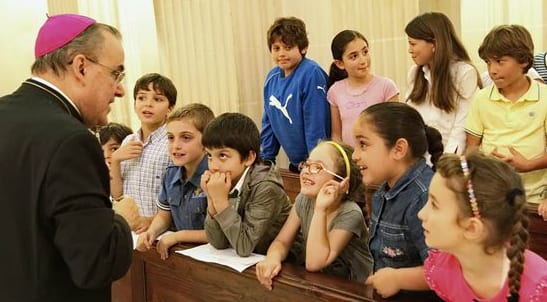Regina Caeli – Queen of Heaven, Rejoice!
The Regina Caeli, Latin for “Queen of Heaven,” is a hymn and prayer ...

This post is also available in: Italian
Part 2 of a four part series on the role the magisterium or sacred teaching office of the bishops and pope of the Roman Catholic Church.
If the term “Magisterium” means “teaching office” and refers to the teaching role of the Pope and bishops, where does that leave all the other teachers in the Church–parents, catechists, professors, priests and deacons?
The answer is, it leaves them with a lot of work to do!
The passing on the Catholic Tradition to people who have yet not heard the gospel, whether they be new generations of Catholic children or un-evangelized peoples–this is a task that requires the efforts of the whole Church (DV10). The teaching activity of the Church is certainly not limited to the hard work of our pope and bishops.
Their unique teaching role, however, is that they, as successors of the apostles, judge authoritatively what is in accord with the gospel and what is not. The teaching of the Magisterium sets the standard.
In formulating their teaching, the Pope and bishops rely on the help of theologians who are not bishops. And myriads of teachers pass on and explain the teaching of the Magisterium once it is formulated. Yet it is clear where to look to know the authentically Catholic position on a subject. When we say “the Church teaches” something, we are speaking about the teaching of the Magisterium.
But this magisterial teaching is presented to the church in diverse ways. First of all, there is the distinction between the local and the universal Magisterium.
Local bishops preach day in and day out and sometimes write pastoral letters to their flock. Occasionally they meet together with other bishops such as in national bishops conferences. The documents that flow from such occasions would be exercises of the local Episcopal Magisterium. But the common teaching of bishops worldwide obviously carries more weight since it is an expression of the universal Episcopal Magisterium. The Pope, though he has pastoral responsibility for the local diocese of Rome, is the successor of Peter. In that capacity, he has a unique responsibility and authority to feed the whole flock (John 21), so all of his teaching is an exercise of the universal Magisterium.
But as we examine the Papal Magisterium, we see that its teaching takes many forms.There are the daily homilies, audiences, and addresses (sometimes called “allocutions”).Then there are documents of various types. Some come from the Pope directly, such as apostolic letters, encyclicals, and ever more solemn “apostolic constitutions.” Some come from the departments of his “curia” or administration, such as the Congregation for the Doctrine of the Faith.
All of these are expression of the universal, Papal Magisterium and therefore are important. Yet the different forms help indicated different degrees of importance. For example, when the Catechism of the Catholic Church was officially presented to the world by Pope John Paul II, he chose to promulgate it through an Apostolic Constitution, indicating the supreme importance of the Catechism as an expression of Catholic Faith.
This brings us to an important distinction between the kinds of subjects covered by magisterial documents. The Church militant is a family of some 1 billion people. Like any family, there must be various rules to keep things running smoothly. Some of these rules are not necessarily God-given moral laws but are rather regulations developed by the heads of the household to keep good order. Such things are referred to in the Catholic community as matters of “discipline.” Liturgical issues such as when we kneel or stand at Mass, holy days of obligation, fast and abstinence laws, and priestly celibacy–all these are examples of discipline. These practices, given their human origin, have changed over the years and can vary from place to place in the Catholic world.
“Doctrine,” on the other hand, refers to the teaching about God and his plan for our lives that flows from Divine Revelation. Doctrine, or teaching pertaining to faith and morals, has a direct bearing on our salvation. It is not of human origin but comes ultimately from God, though it is expressed in human words. God’s truth does not change. The Church’s understanding and articulation of it can get clearer and deeper as time goes on, so we can speak of “development of doctrine” (CCC 94). But there is no question of some arbitrary change in doctrinal teaching on the part of the Magisterium.The Magisterium cannot subtract from or add to “the deposit of the faith”– only pass it on, explain it, and defend it.
“Dogma” is best understood as a subset of doctrine. Dogmas are doctrinal truths which the Magisterium proposes without hesitation as being revealed by God and therefore binding on the faithful (CCC 88). That Jesus is true God and true man, that the one God is a Trinity of three persons, that the Eucharist is truly the body and blood of Christ–these are dogmas that must be accepted by all who wish to call themselves Catholic. Many of these dogmas have been solemnly defined by ecumenical councils and in a few cases, Popes. But before they were defined through such extraordinary acts of the Magisterium, they were already taught as dogmas through the universal, ordinary, exercise of the Episcopal Magisterium as bishops went about teaching their flock throughout the world, day by day.
For the rest of the series on the Magisterius, see:
Magisterium, PART I
Magisterium, PART II
Magisterium, PART III
Magisterium, PART IV
No Comments